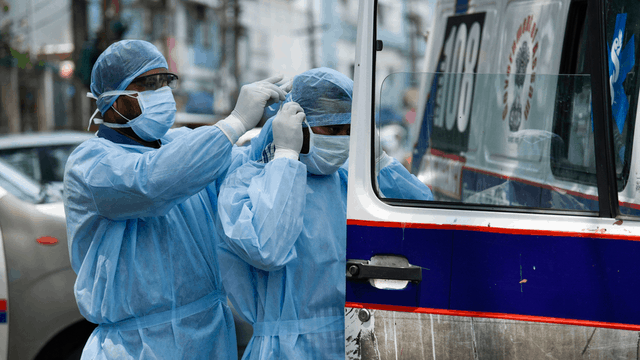August 24, 2021
Large surveillance study suggests gaps between observed and expected COVID-19 mortality in India. A prospective, active surveillance study led by researchers at CDDEP and the University of California, Berkeley, assessed predictors of SARS-CoV-2 infection and mortality in the district of Madurai, Tamil Nadu, India. The study showed that age was a positive predictor for symptomatic RT-PCR-confirmed infection. Moreover, older age, male sex, and underlying diseases were associated with increased mortality risk. However, higher than expected values of age-standardized mortality suggest surveillance in Madurai only captured the more severe cases in the clinical spectrum. Authors estimate that recorded infections among those 15 years and older amounted to only 1.4% of total infections in that age group. Active surveillance and investigation of all-cause and cause-specific deaths in low-resource settings are essential to understand the actual burden of the disease. [The Lancet]
Persistent COVID-19 infections – an urgent need for treatment options. Persistent COVID-19, driven by the inability of the immune system to clear the infection, occurs in a small cohort of COVID-19 patients who have often been overlooked in randomized trials investigating treatment options. In addition to long periods with debilitating symptoms, ongoing infection in these immunocompromised patients can lead to viral evolution and emergence of new strains in the wider population, emphasizing the urgent for treatment strategies to reduce morbidity and protect public health. [The Lancet]
Imported Ebola infection detected in Ivory Coast. An Ebola infection was recently detected in Ivory Coast’s Abidjan. Officials say that the patient, an 18-year-old woman who traveled from Labe, Guinea via road, is an isolated, imported case not linked to an earlier outbreak in Guinea this year consisting of 23 cases and 12 deaths. With assistance from the WHO, the Ivory Coast Ministry of Health has deployed a swift response to this outbreak, resulting in identifications of 39 contacts and vaccination of more than 800 people, reflecting the high level of Ebola outbreak preparedness in place. [CIDRAP]
COVID-19 surges associated with increased HAIs rates in US hospitals. A recent US study shows that healthcare-associated infections (HAI) rates in 148 US hospitals during March and September 2020 were higher than expected for central line-associated bloodstream infections (60%), catheter-associated urinary tract infections (43%), and methicillin-resistant Staphylococcus aureus (MRSA) bacteremia (44%) . These findings illustrate the pandemic’s impact on other infections and underscore the importance of maintaining or ramping up infection prevention control routines for other pathogens. [Clinical Infectious Diseases]
COVID-19 is associated with increased morbidity and mortality among women giving birth. A cohort study involving 869 079 adult women who underwent childbirth between March 2020 and February 2021 revealed that women infected with COVID-19 were more likely to have a preterm birth (16.4% vs. 11.5%) and had higher rates of ICU admission (5.2% vs. 0.9%), invasive respiratory support (1.5% vs. 0.1%), and in-hospital mortality (0.1% vs. <0.01%). [JAMA Network]
Long-term COVID-19 symptoms among home-isolated patients. Researchers in Norway conducted a prospective cohort study to document symptoms experienced by 312 COVID-19 patients (247 home-isolated and 65 hospitalized). At six months, 61% of all patients had persistent symptoms, independent of illness severity. The experience of consistent dyspnea, fatigue, and cognitive impairments among half (32/61) of the young, home-isolated adults aged 16-30 years, highlights the importance of continued infection control measures, including vaccination. [Nature]
Genomic data documents origins of S. Typhi strains in the UK and drug resistance profiles. A recent UK study conducted a prospective genomic analysis of 1742 isolates of typhoidal salmonellae between 2016 and 2019 to assess trends in incidence, antimicrobial resistance, and associations with international travel. Yearly Salmonella Typhi and S. Paratyphi A cases increased by 48% and 17.3%, respectively, and were associated with travel to South Asia. The increase in multidrug-resistance and new extensive drug-resistant (XDR) profiles, most of which were associated with travel from Pakistan (94%), warrant the update of clinical guidelines for managing imported infections. [Microbial Genomics]
The investment case for malaria elimination in South Africa. Researchers in South Africa developed a dynamic mathematical transmission model to estimate the costs and benefits of several malaria elimination strategies: “Business as Usual,” “Accelerate,” and “Source Reduction.” The study predicted that the national elimination of malaria is achievable within eight years with sustained investment. The investment case resulted in an unprecedented increase in political support from the government of South Africa and an estimated increase of 36% in provincial malarial budgets. [Malaria Journal]
Declining drug susceptibility among Neisseria gonorrhoeae isolates in Germany. The German national surveillance system reports increasing antimicrobial resistance among Neisseria gonorrhoeae resistant isolates. Data from 2014 to 2021 reveals an increase in isolates with an azithromycin minimum inhibitory concentration of >1 mg/L from 0.5% in 2012 to 12.2% in 2020. Additionally, findings suggest increasing resistance to penicillin and ciprofloxacin, raising questions on the suitability of ceftriaxone and azithromycin treatment combination in the near future. [Eurosurveillance]
Photo: Shutterstock












